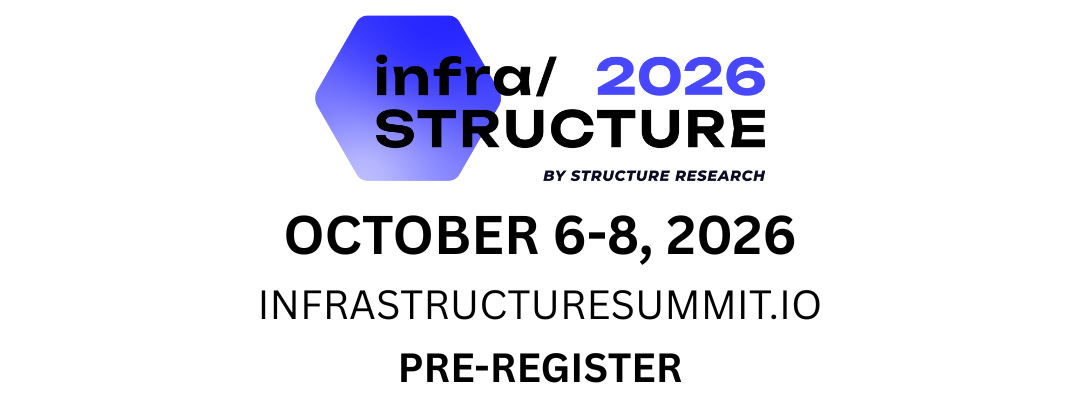WSS: infra / STRUCTURE 2025 debates the future of hyperscale infrastructure, coming out with measured optimism and realism
We had a slower publishing schedule this past week due to the sixth annual infra / STRUCTURE summit, which was held in Las Vegas on October 15-16, 2025. This was our most successful event yet as we had close to 700 delegates registered and a full roster of sponsors. The summit would not have been possible if not for this extremely generous level of support. Thanks again to our cornerstone sponsor Citizens. They were the driving force behind the summit moving from Toronto to its new permanent home in Las Vegas (last year for the first time), opening the door for us to reach new levels. We also want to extend our gratitude to gold sponsors Switch and TD Securities. Finally, we’d like to call out two sponsors that have participated in all six of our summits: Citizens and Layer 7 Capital. There were too many sponsors to call out here individually, so please visit our website to see our full roster. We continue to be grateful for all your support and please save the dates now for next year: October 7-8, 2026 in Las Vegas (returning to Wynn Las Vegas).
In this space we usually summarize the past week’s main developments from across the sector, while providing some quick commentary and analysis. Given publishing was slow last week, we thought it would be useful to quickly point to some of the main takeaways and themes from the summit.
We like to go with one-word themes and in 2023 it was recalibration, followed by last year’s theme: rethink. In the last two years the theme of the summit revolved around change, and to some extent, that was the case again this year. Our theme concurrence was meant to capture how change and transformation has started to intensify and reach another level. The sector has always had many moving parts, but the situation today is unprecedented. So many things are happening at the same time, and in many cases, they are coming up against each other. Demand is accelerating but supply has not been able to keep pace and is being limited due to constraints around resources (land and energy) and supply chains (chips and hardware), while the underlying infrastructure technology building blocks are changing as CPUs have been joined by GPUs and air cooling is making way for liquid-based cooling systems. Meanwhile, geopolitics is creating headwinds and global trade issues are causing uncertainty as the sector tries to expand globally. And at the heart of all this are capital constraints, security and compliance issues, and more complicated questions around data sovereignty, regulation and privacy. As if that was not enough, planning horizons are getting longer, capacity and growth projections are more difficult, and there is the challenge around communities and social license.
With concurrence as the backdrop, the main sector flashpoint this year has been the bull versus bear debate about the sector’s current status and outlook. The DeepSeek revelations and hyperscale pullbacks earlier this year sparked concerns about a possible overbuild, while the allegedly circular movement of capital around the NVIDIA GPU ecosystem has raised concerns that there is an impending bubble. The concerns are fair, but the debate and discussion last week seemed to slant in favour of measured optimism. Most agree that the sector’s demand profile and growth trajectory are built on solid fundamentals and hyperscale public cloud remains the driving force behind the sector, with AI still in its formative stages, but set to provide an accelerant to everything that has been happening since AWS entered the market back in 2006. A lot of the discussion at the summit agreed with the notion that the sector will see phases and oscillations based on supply and demand moving out of balance, and this could happen in the next few years, especially if there is an energy crunch. How bad an energy shortage might be hard to predict, but most would agree that a slowdown would be temporary. The longer we are away from an energy shortage, the better for the sector as there will be more time for alternative energy sources to continue making progress. We had a session focused on nuclear that is building optimism for this technology and the expected time horizon, while other sessions explored alternative and bridge solutions that are sure to soon be a real part of the constantly evolving landscape.
A business as dynamic as this one is also seeing business model transformation. A topic of discussion at the summit was the master-planned data centre model, which is young but proving to be legitimate. The model addresses a challenge that hyperscalers and data centre operators alike face, and there is evidence of meaningful demand levels. This is just one of many opportunities and market inefficiencies that have started to pop up across the landscape and this has drawn in new operating platforms. The hyperscale AZ data centre business remains a good one, but that is not all that is out there. There are deployment models that make sense in a hyperscale and AI world, and the universe of multi-MW buyers is also expanding. Neoclouds are now driving leasing alongside the usual hyperscale cloud platforms.
There is no question that the sector is healthy and interest has never been higher. New operating platforms continue to be formed and widespread investor interest is backing these new ventures. And why would capital not be looking at hyperscale and AI infrastructure? Building out all this infrastructure is going to take tremendous amounts of capital and a few of the summit’s sessions touched on how not just operators, but now hyperscalers are looking to the capital markets to support development, growth and expansion. And financing strategies have been forced to be as creative as ever before, given the new profile of customers, the massive numbers and the unpredictable and extended timelines. The strategic landscape is evolving quickly. M&A has not been as frequent as we have seen in past years, but valuations continue to be sky high. Just before the summit kicked off last week, Aligned Data Centers was acquired for $40b by a consortium headed by MGX and BlackRock’s Global Infrastructure Partners, with participation from Microsoft and NVIDIA. We will have more on this as we resume publishing research, but it is clear that interest in the sector, and the stakes, have never been higher.
Finally, one of the highlights of the summit was the growing participation we are seeing from hyperscalers and the neoclouds that are populating the landscape and serving as NVIDIA and AMD’s delivery system for GPU-based AI infrastructure. Nearly all major platforms were represented at the summit and the hyperscale community is increasingly seeing the value of being a more integrated part of the data centre and cloud infrastructure services sector. We plan to build on this moving into 2026 and look forward to building a true ecosystem event where hyperscaler end users work meet, collaborate and partner directly with all the suppliers that they increasingly need to meet the challenges of the market. These are truly exciting times and we thank you again for your unwavering support. All the best from all of us here at Structure Research.
or



